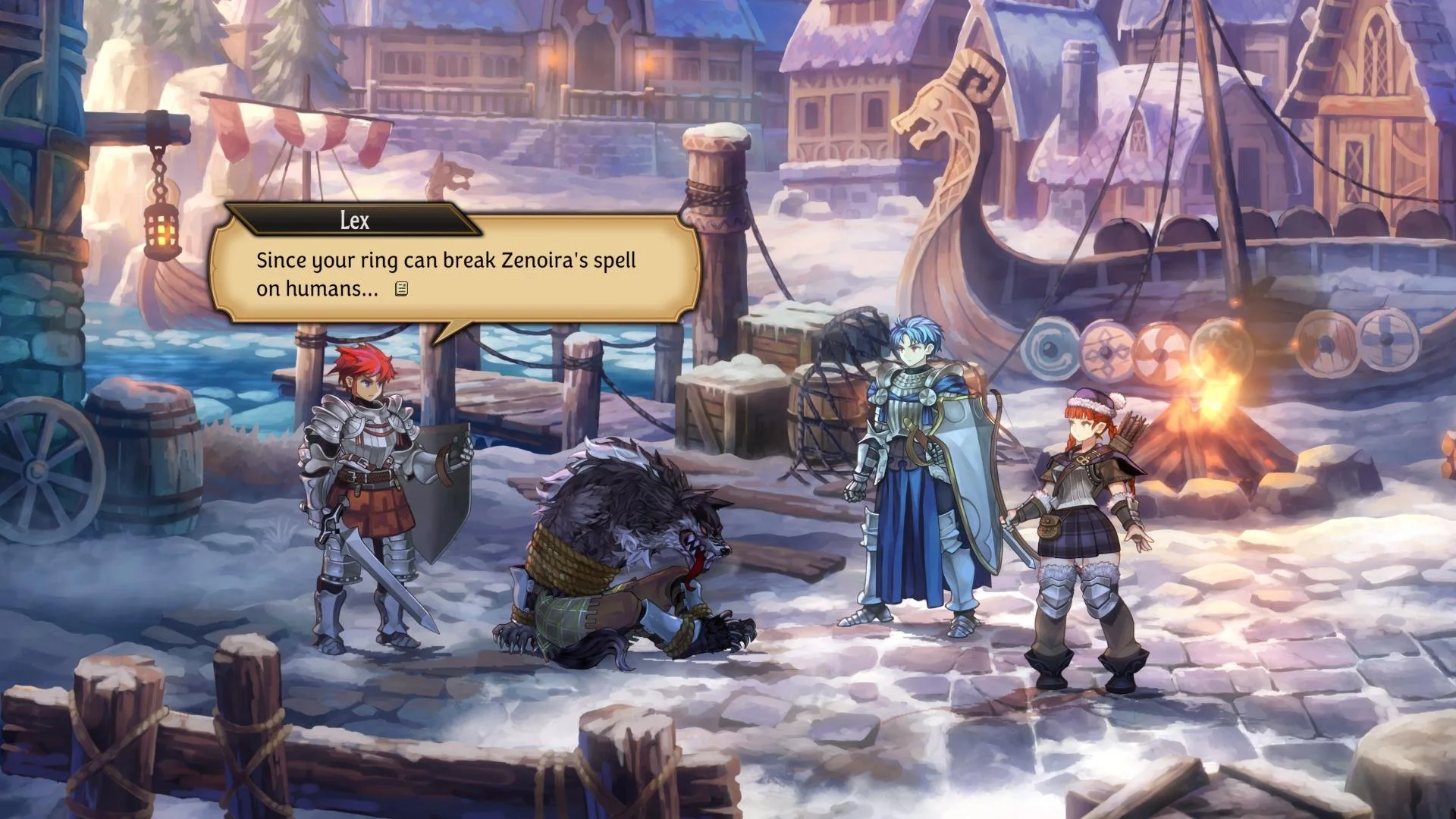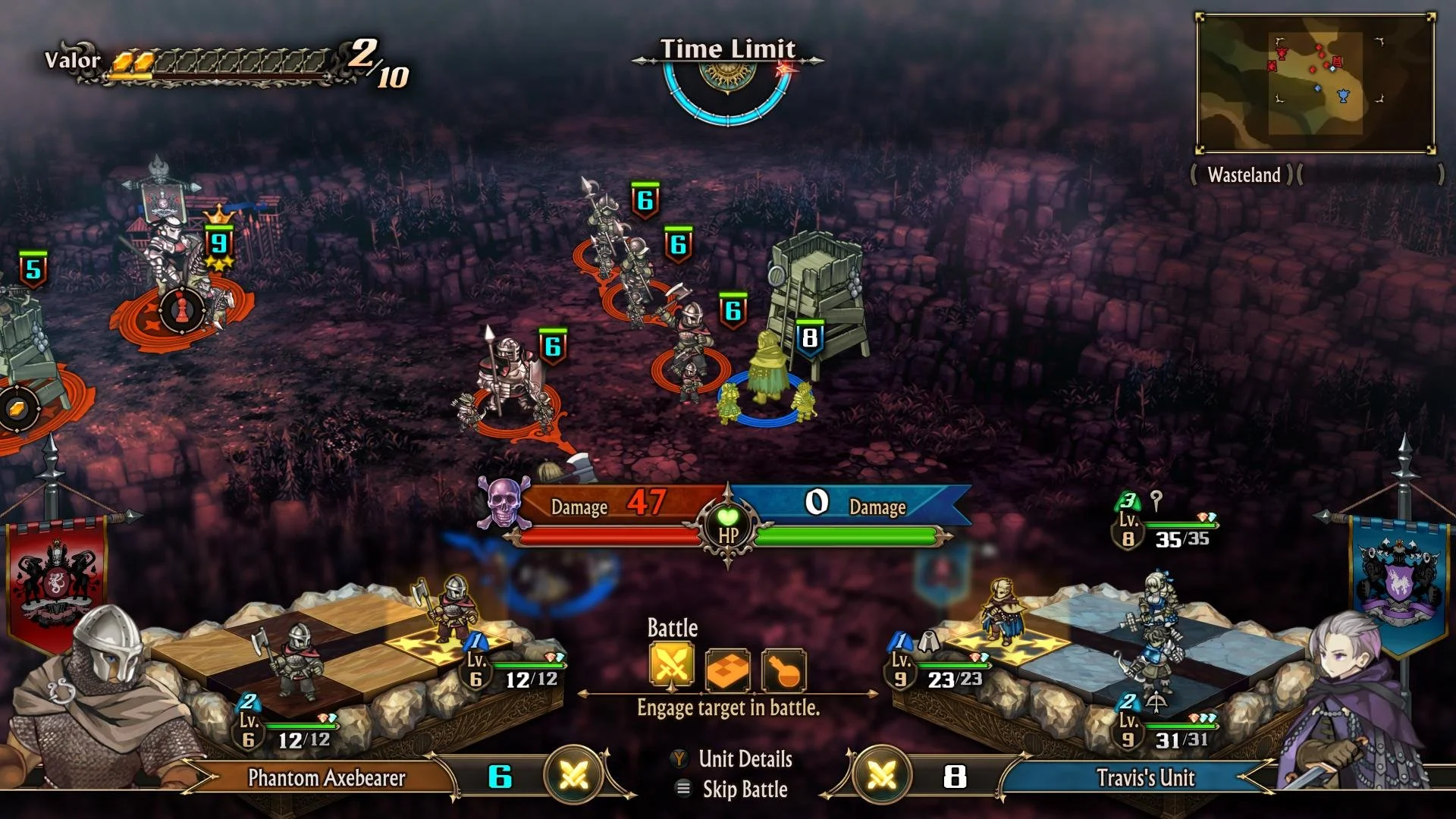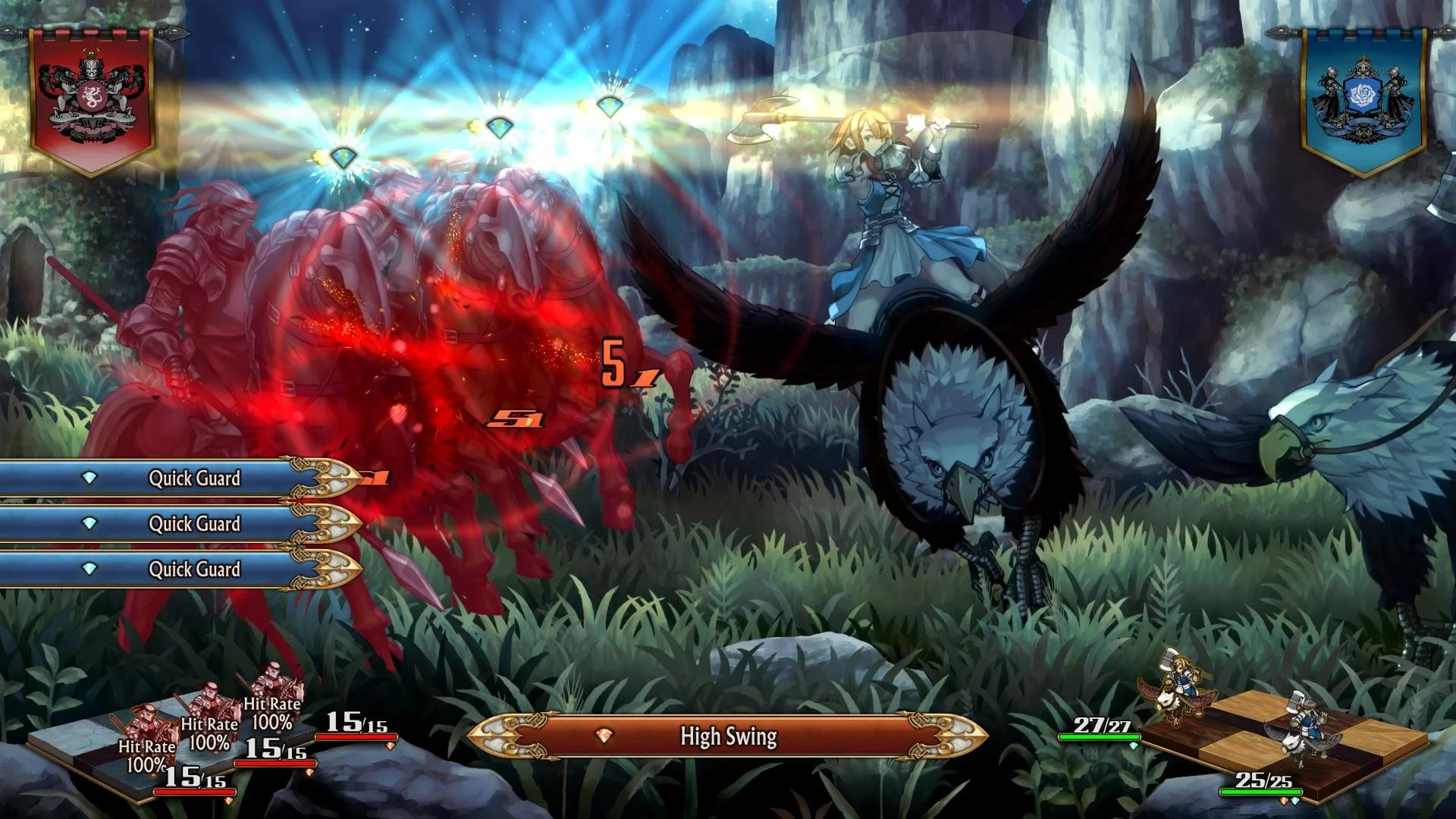Tactical Perfection
Vanillaware has had a remarkable history built upon a very particular art style. From GrimGrimoire to Odin Sphere to Dragon’s Crown, their games are recognizable across the industry. To add, each of their titles bleed into other genres, rarely staying in their lane, providing a significant amount of depth when you were least expecting it. This philosophy remains intact with their latest release, Unicorn Overlord, a tactical auto-battler that pulls from the best qualities of what we've seen in Fire Emblem and beyond. This 50+ hour tactical journey about reclaiming a defeated kingdom is stunning from beginning to end.
Unicorn Overlord’s story may initially feel far too familiar; a young man in the custody of a magic ring must turn to a varied collective of swordsmen, elves, and more, all in an effort to take back a land that has been all but lost. The backbone of this narrative also follows in the tried and true footsteps of the Queen of these lands putting her son in the custody of her most devoted general as she heads off to fight a battle she knows she won't return from. And while all these elements are familiar, it is the characters that make this journey so absolutely fulfilling.
Alain, who has been in hiding since his mother, the Queen, fell in battle to a man named Galerius, a warlord who has conquered these lands for the past ten years. Since that time, Alain has trained under his mentor and father figure in Josef. While his whereabouts have been secret, this adventure starts through the spark of rebellion as Alain and company are finally discovered. Unicorn Overlord is about this rebellion and the quest to take back the continent of Fevrith from the clutches of evil.
If I had to knock Unicorn Overlord at all, it would be that Alain as a character is a bit limited in his development and depth as a lead. He's the righteous leader who wants the best for his people, but his approach is as simple as coloring within the lines, especially with an incredible number of personalities around him. He’s not exactly a blank slate, but he is far too predictable of a main protagonist and almost runs the risk of being a tad bland.
While Unicorn Overlord is a tactical auto-battler, it is first and foremost about its characters. Alain will make nearly 70 allies across his journey to take back these lands. Some of the companions will join the Liberation Army from one of several plot beats, whereas a few will find their way to you through one of several side quests. Some of these encounters may have you make choices on whether they live or die, put to your blade should their offence be too great. It's also worth pointing out that you won't have room on each of your formations for the whole cast, so picking and choosing who is right for your cause is part of its charm.
Much like Fire Emblem, the relationships you have across your small army can be critical to the experience. From sharing a meal or simply fighting alongside them, those bonds grow and lead to compelling character moments. Oddly, these are the only times the game doesn't provide voice work for its cast in moments that feel like they should. Regardless, adjusting your formations have just as much importance through combat as it does for morale, ensuring you are getting the most of your time with the 70-strong roster.
If I had to criticize any aspect of this large ensemble, it's that a few characters don't really get their moment to shine, at least during the big narrative moments. You also have a few characters that feel like tagalongs to the more prominent ones, such as Colm and Leah, who are likely to be characters you’ll replace with the more front-and-center cast as they become available. I'll stress this is a minor issue as having more combat options at certain points in the story is never a bad thing, especially as an alternative to creating a few mercenary hires that lack the personality and design of its central cast. Still, having access to hire a particular class at any time can make your team extremely formidable.
As you work your way through each of the five territories, you'll begin to grow your army, granting you access to different types of units. From swordsmen to archers, to those on gryphons and horses, you'll have to create formations out of how each unit reacts into battle. This is due to the fact that much like an RTS, you'll move the unit towards an enemy and it will auto-attack on its own. While this may initially give off the air of being something a bit too simple, there is a staggering amount of strategy here that becomes apparent when you start to tinker with your formation, their skills, and how each of them operates.
In this case, that unit is a mixture of up to five characters on a 2x3 grid. Placing a unit at the front or rear can result in how effective that unit is. Tanky characters certainly should be on the front lines, while the more vulnerable types should make up the back row. There is a lot of strategy here especially when you can tinker with their AI to use certain skills under set conditions, such as your healer tending to the party member with the lowest health first or using a particular skill on an armored foe at the start of the fight. In fact, this system of creating builds with each character and how their skills will react to the circumstances you place upon them is beyond impressive. To be honest, this system can become almost too overwhelming until you really put a good amount of time into it.
How combat works is that you use Valor points to deploy a single formation of characters. At the start of the game, you'll only be able to build formations of two characters, and then eventually three, four, and finally five. This limitation is based on your Liberation Army level, which increases as you make yourself known across Fevrith. Each formation, and additional formation slots, can be upgraded by using a currency called Honors, but only once you earn the level to do so, which is largely progress-locked as you'll often have the desired level around certain narrative points. This is to prevent you from growing far too fast for the challenge at hand.
Once deployed, you'll then start to position units against targets by selecting the target or a spot behind them, allowing them to attack anything that gets in their way. Like Fire Emblem, it will showcase how much damage you may do and how much you'll receive as you approach each threat. Valor can also be used to pull off a variety of unit specific skills, such as axe swings or a barrage of arrows. These vary based on your unit's formation and its cast. By directing your units around, they will then attack whatever they come into contact with, or can be directed to use catapults or other offensive weaponry strewn about the battlefield.
Those valor skills can weaken your target as well as attack multiple units at once, making it a solid strategy to save up your valor to pull them off instead of bringing more units out until you need them. You can also capture numerous garrisons to earn additional valor. Depending on the difficulty you've chosen, you can often deploy only a fraction of your army to pull off a victory. And since valor attacks or even using items don't have a cooldown, you can continue to pull off these attacks as long as you have the valor to do so. There is a lot of freedom in how you attack.
While there is a timer to each skirmish, I rarely found myself at any nail-biting conclusion. Matches certainly tested my team, but keeping them appropriately leveled was easy enough as there are trials you can take on as often as you want, rewarding you with not only experience for those you deploy, but each victory rewards you with several experience books, many of which grant even more experience to a unit if it's under a certain level requirement.
Similar to Fire Emblem, you'll have class types that are better against others. Hoplites, for example, are a walking fortress to many units. They are great against fighters, cavalry, archers, and soldiers. However, for as strong as they are, they have weaknesses to hammer-wielding warriors and spellcasters. Hunters, which grant the use of a bow, are weak against hoplites, fighters, and cavalry, but are strong against thieves, flying units, and sword fighters. The remaining class types not mentioned consist of sellswords, gladiators, knights, sword fighters, wizards, shaman, gryphon knights, and more. So, mixing your team with these classes to effectively have no gaps in your armor can make or break a formation.
Some maps will have obstacles to overcome. From desert storms that reduce visibility, to the same hindrance during a harsh winter storm. There are also a few instances of thorns preventing you from leaving your units on their own as they may often stray from the safe path to find their target. One map had a series of geysers that teaches you about items that prevent environmental damage for a few precious seconds. Granted, these items are not easy to come by, but they certainly help out where they can. The game isn't littered with too many of these hazards, but you'll certainly find them from time to time, largely found in the main story scenarios.
When you are not taking part in battles, you’ll be traversing its open areas either on foot or on horseback. Thankfully, you can equip a leader to your formation that has a horse, allowing Alain to move around a bit quicker. Eventually, Alain will be granted a horse once you can promote your classes to their higher class, complete with a slightly changed attire. Navigating the five territories has you encountering small towns that have occupied forces that are keeping them captive. By defeating these forces, you’ll have access to the town for commerce and more, allowing you to purchase new gear, items, and taking in a meal to boost the morale between a small group of characters. You'll also find barracks to upgrade your available tile size to increase your deployment size or to hire new recruits using that aforementioned Honors currency.
Each town or settlement can be upgraded as well, boosting your presence with them. This is done by delivering items that they request, resources that you’ll find constantly around you. Each village has a rating, and delivering anywhere up to a few items will see them level up. That said, once you are maxed, any deliveries after that will only grant the standard rewards of renown, gold, and items. You'll also find crystal shards around the map you can take to a shop run by a character that'll join your squad fairly early on in the game. And combine that with a coliseum that rewards you with an extremely strong ally, and you’ll never be short of things to take on here.
The map itself also contains a variety of items and resources to collect and other faculties you'll discover in due time. Some characters you'll recruit later on will tend to those discoveries eventually, so there are moments in the game where you'll be unclear on what you'll need at the time. Still, the world created here gives you a tremendous amount to do that never feels boring or repetitive. And with a ton of side quests and additional skirmishes away from the main story, and you can often find your way across Fevrith how you see fit.
Seeing Unicorn Overlord in action is a true work of art, especially given the superb art assets used to bring it to life. Fans of their previous work will find a truly gorgeous game here. My only minor complaint is that some of the male characters don't carry the same quality when it comes to their faces. Nonetheless, the backgrounds and character art across this game are absolutely stellar, even with the allowance of using an item to change the colors of every single character.
Adding to its presentation, the voice work here is too notch. With such a massive cast, I am shocked at how much voice is present. Hearing Cyberpunk actor, Cherami Leigh here was a treat, especially as she gives the same level of performance as she did as V. Other strong performances are Skyler Davenport as Scarlett, Brianna Knickerbocker as Yahna, Justine Huxley as Nina, Elizabeth Maxwell as Virginia, among countless others. I was drastically impressed by the quality of work done here to bring this game and its characters to life.
After trying the lengthy demo shortly before release, I was eager to try this game out and experience it from top to bottom. Thankfully, Unicorn Overlord never faltered and has cemented itself as one of the best tactical strategy games I’ve ever played. The similarities to Fire Emblem are certainly there, but its gameplay during battles presents a different approach to its combat that absolutely soars. From its strong visual presentation to its ability to skip battle animations and many of its menu systems, Unicorn Overlord is a game that respects your time and deeply rewards you for it.
Developer - Vanillaware. Publisher - Sega (WW), Atlus (Japan). Released - March 8th, 2024. Available On - Xbox Series X/S, PS4, PS5, Nintendo Switch. Rated - (T) - Blood, Fantasy Violence, Mild Language, Mild Suggestive Themes. Platform Reviewed - Xbox Series X. Review Access - Review code was provided by the publisher for the purpose of this review.



















Jeff is the original founder of Analog Stick Gaming. His favorite games include The Witcher III, the Mass Effect Trilogy, Hi-Fi Rush, Stellar Blade, Hellbade: Senua’s Sacrifice, and the Legend of Heroes series, especially Trails of Cold Steel III & IV.